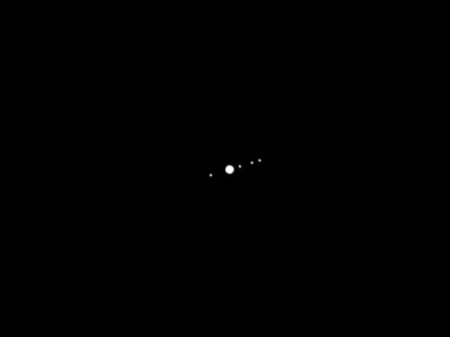I've had one, repeat, one (1!) night with clear skies since I wrote the last post. I did make the best I could of that and hopped in the car armed with binoculars and some idea of what I wanted to look at. I stayed with Orion because, well, because I need to start somewhere.
So I went over what I already knew about it; Betelgeuse, the Orion nebula, and then stayed with Rigel for a minute or two. Realized that I don't really recognize as many constellations as I thought I should and had a look at what little I knew I could name: The big dipper and follow the backside of the "cart" (the Swedish name for it, Karlavagnen, means a cart not a ladle) up until I find Polaris. Okay, check.
Then took the binoculars down and looked up and around. Found a very bright star seemingly alone, straight above me. What is it? Well, here's where my SkyView app came in handy. I pointed it straight up, and it told me the name of the star. What was it? I don't remember. But then tonight, as I was writing this post I used the simple fact that I'm still in the same place, it's the same time of year, and even though it's a cloudy night SkyView doesn't care what the outside looked like. So sitting in my couch I pointed my phone up and, sure enough, there it was. Capella.
Capella is a pretty cool star in that it's not a star at all. It's actually four stars, but the two that you can see (although "they" sure looked like "a" star through binoculars) are two giant stars circling each other very closely. How closely? About the distance of the earth to the sun! Two stars, the smallest of which has a radius of 9 times the sun, circling each other closer than our sun is to us. To put that into perspective, if that can be done, it's... Well, if you're on the surface of the bigger of the two stars and look up at its sister in the sky, it would take up (if my calculations are correct, see picture) 7.5 degrees of the sky, or fifteen times the apparent diameter that the sun has in our sky.

I haven't done trigonometry for quite awhile, but I had help from a Certified Math Teacher who I'm married to who made sure I wasn't getting too far off track in doing the calculations. Once I was done, I tried to find out if there was a way to look up the answer online and found out that someone - of course - has written a Wikipedia article on angular diameter which is used for specifically this. Still, I feel a little bit smarter for figuring out the equation on my (mostly) own instead of googling it.
Now, please - some clear skies!
So I went over what I already knew about it; Betelgeuse, the Orion nebula, and then stayed with Rigel for a minute or two. Realized that I don't really recognize as many constellations as I thought I should and had a look at what little I knew I could name: The big dipper and follow the backside of the "cart" (the Swedish name for it, Karlavagnen, means a cart not a ladle) up until I find Polaris. Okay, check.
Then took the binoculars down and looked up and around. Found a very bright star seemingly alone, straight above me. What is it? Well, here's where my SkyView app came in handy. I pointed it straight up, and it told me the name of the star. What was it? I don't remember. But then tonight, as I was writing this post I used the simple fact that I'm still in the same place, it's the same time of year, and even though it's a cloudy night SkyView doesn't care what the outside looked like. So sitting in my couch I pointed my phone up and, sure enough, there it was. Capella.
Capella is a pretty cool star in that it's not a star at all. It's actually four stars, but the two that you can see (although "they" sure looked like "a" star through binoculars) are two giant stars circling each other very closely. How closely? About the distance of the earth to the sun! Two stars, the smallest of which has a radius of 9 times the sun, circling each other closer than our sun is to us. To put that into perspective, if that can be done, it's... Well, if you're on the surface of the bigger of the two stars and look up at its sister in the sky, it would take up (if my calculations are correct, see picture) 7.5 degrees of the sky, or fifteen times the apparent diameter that the sun has in our sky.
I haven't done trigonometry for quite awhile, but I had help from a Certified Math Teacher who I'm married to who made sure I wasn't getting too far off track in doing the calculations. Once I was done, I tried to find out if there was a way to look up the answer online and found out that someone - of course - has written a Wikipedia article on angular diameter which is used for specifically this. Still, I feel a little bit smarter for figuring out the equation on my (mostly) own instead of googling it.
Now, please - some clear skies!

